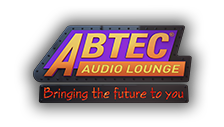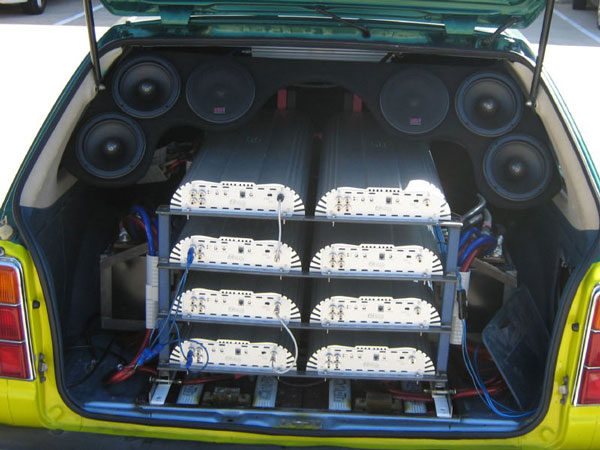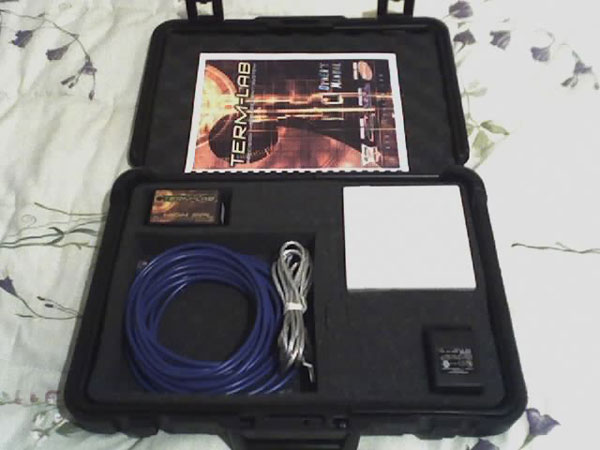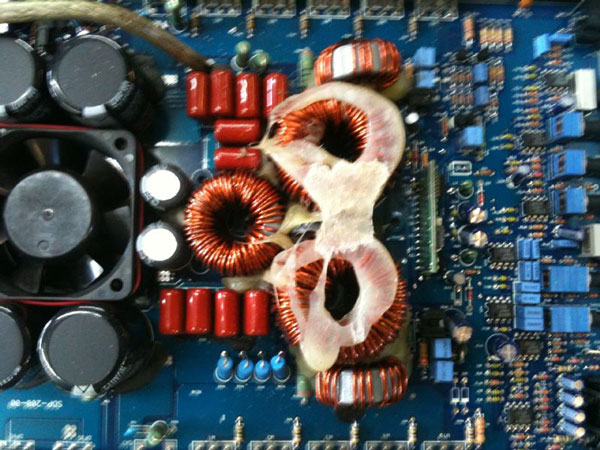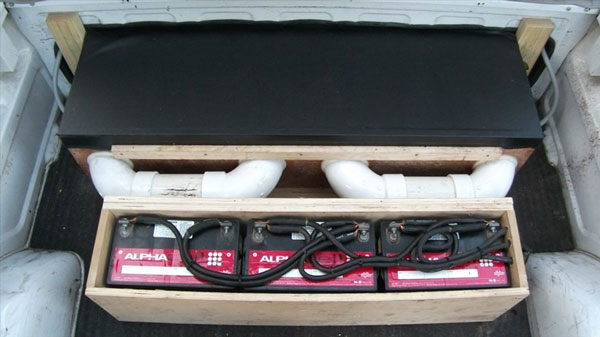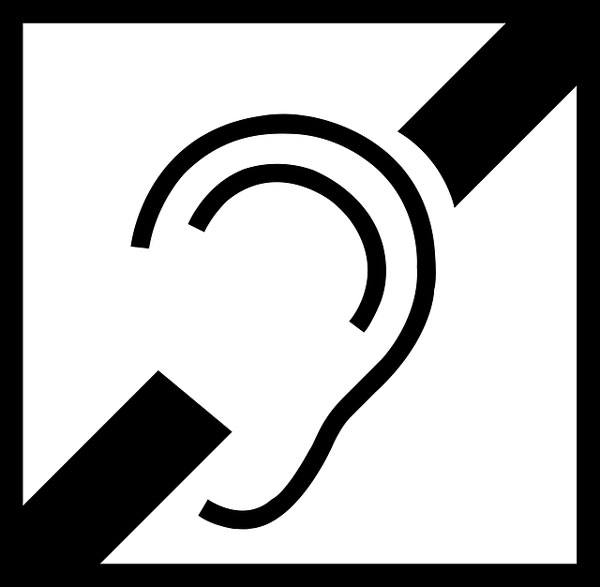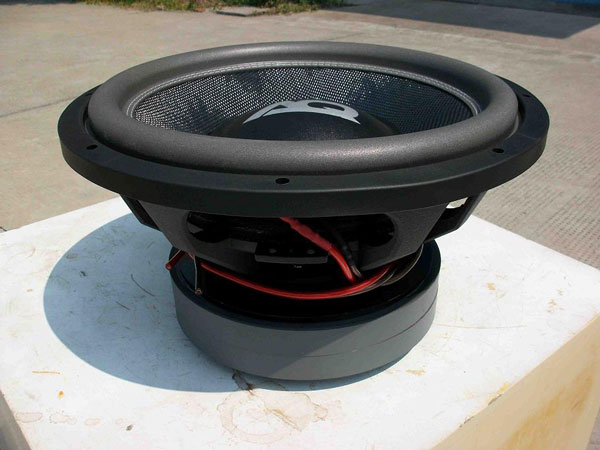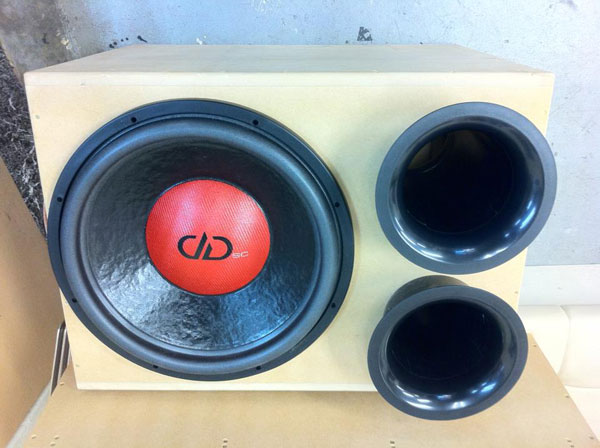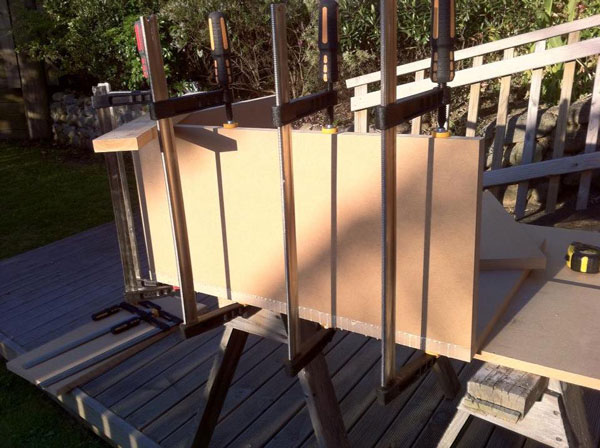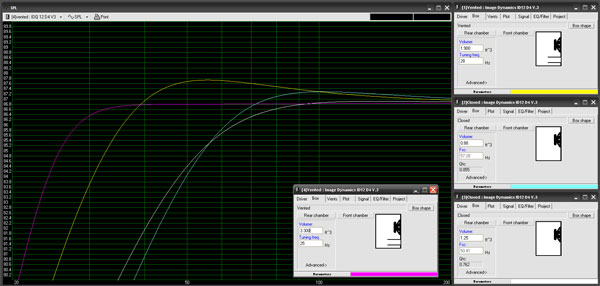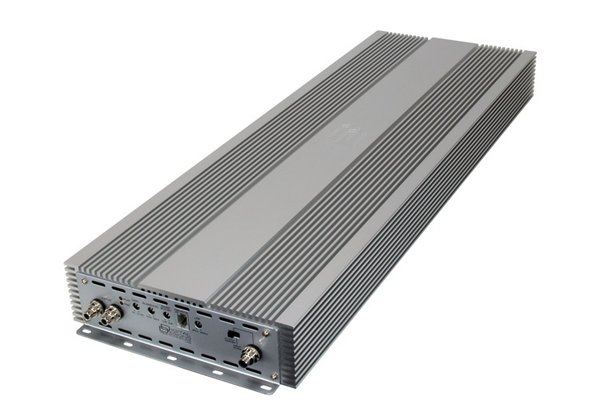Since we get a lot of questions regarding Car Audio Sound Systems Set-up’s we thought it would be a good idea to put up this basic guideline for you all to read through & also to shed some light on the subject at the same time…
Use A Sound level Meter:
If you are serious about Car Audio, use, borrow or buy a sound level meter.
A sound level meter can save you lots of money in the long run.
The reason for using a sound level meter is because once you have your system complete, it may take a big increase in amplifier power to see a slight 1 to 3 dB increase in sound pressure levels, just think of how much money it would take to double the number of amplifiers you have! It would be much cheaper to buy sound level meter, re-tune and design your system better. Noticing what changes in design makes your dB level go higher with a use of a sound level meter.
Unless you have had a lot of experience you may not perceive this correctly. Furthermore, system changes can cause resonant frequency changes.
This is important because the human body does not accurately rate sound pressure levels, Especially at different frequencies. I have seen many people incorrectly guess the sound pressure level of a relatively low 138dB into thinking it was 150dB, because it was at a very low 24hz instead of the usual 45 to 65hz.
If your system is using a ported box, a sound level meter will let you see how much slight changes in the length or size of the ports can make a big difference in your sound pressure levels.
Don’t Buy Junk:
Please do yourself a favour… Don’t buy junk or junk brands!
Do you ever go down to the supermarket and think to yourself “I wish they had a toothache or headache I could buy?” I didn’t think so! No one wants to buy a toothache and most times a junk brand piece of electronics are just like a toothache, So don’t buy one!
Junk brands means you or your local Car Audio shop have never heard of it, or never heard it with their own ears. Also just because something is low price does not mean it is junk. Low price brands are better than the junk brands and for many people the low price brands are good enough, it works and sounds good enough. Junk brands are like buying a toothache or a really bad headache. Stolen, lost, or dirty beat up radios from the swap meet are considered junk.
Reason 1: Junk usually costs almost the same as the good stuff or at least 80% of the price, which usually means if you just save your money for another month or so you can get the name brand item. I know not all of us are millionaires and a lot of us have kids to support, so just buy the name brand item one piece of the system at a time every 3 or 4 months or so. Time will go by and sooner than you think your going to have a really good system.
Reason 2: Junk stuff breaks alot faster than the name brand items. If your impatient and cant wait another month your going to suffer when that junk brand you bought because you were in a hurry, BREAKS. And yes it will break and break soon. Oh yeah, your going to be without a system until you can save up for the good name stuff and chances are that is going to be alot longer than 1 month you should have waited to save for the name brand item anyway.
Reason 3: If you want to sell your system and it is a name brand item you can sell it used for 35 % to 70 % of what you paid for it new, if it is a junk brand you probably will not even get 10 % to 20 % of what you paid even if your lucky. The reality is you probably won’t even be able to sell it and it will just end up sitting around your closet or garage collecting dust.
Reason 4: The sound quality in junk brands are not as good as the name brand item.
Reason 5: No or a super-weak guarantee with the junk brand.
Reason 6: Usually junk brands use junk parts to make their junk equipment. If your planning to get a hamburger, you don’t go pull up to a Mcdonalds then go to the back rubbish bin and whip out a hamburger! That is the junk, for whatever reason Mcdonalds (Ok, Mcdonalds isn’t the best example but I’m just using as that. An example) decided it is not up to their quality standards so they put it in the rubbish bin. Well big factories do the same thing, junk factories get the junk parts to make the junk brand stuff.
Reason 7: The junk brand stuff leaves out 1 critical feature or ability that the good brand has in order to cut the 20% off of the good brand price. An annoying critical feature left out is secondary amplification on head units, in other words the decks push out a pitiful 1 or 2 watts RMS instead of the standard 17 to 25 RMS. They do this by not putting in secondary transistor amplifiers to cut the price. Another feature that is cut out is the fast forward on the CD play. Another feature you cant see is the radio clarity or the ability to pull in far radio stations, or the ability to lock in on 1 station at a time. No iPod or aux inputs, no memory(s) or shuts off randomly.
Car Batteries:
Car batteries must be given tremendous respect.
Did you know when you start your car, for a microsecond every ATOM on earth “feels” the electromagnet force!
They are very powerful devises. A normal 12 volt car battery has about 10,000 watts of available 1 second power, or about 50 to 100 AMPERES for about 20 to 60 minutes.
Converted to more understandable units, the energy in 1 battery could lift 310 TONS 1 foot off the ground!This is about 620,000 foot pounds of energy!
If it were possible, to get a battery to separate all it’s positive and negative charges it would require a force of about 80,000,000,000,000,000 TONS!
A car battery is called 12 volts but is actually normally about 12.62 volts, a D.C. voltage summary can be approximated like this:
Overcharged = 14.41
Brand New charged = 13.95
Brand New sitting on shelf = 13.7 to 13.10
Good = 12.60 to 13.10
O.K. = 12.45 to 12.75
Weak = 12.20 to 12.45
Dying (needs charging, acid or water) = 11.85 to 12.20
Dead (needs charging, acid or water) = 11.2 to 11.85
Irreversible (can no longer be charged or fixed) = 8 to 11.2
Dangerous (possible internal short don’t be around this car battery) = 2 to 8
The true power flow from a car battery is not from the voltage however, it is from the AMPERAGE (the total flow of electrons). A normal car battery has about 800 AMPERES of instant current dumping ability. Taking the VOLTAGE (13) divided by the AMPERES (800) gives the OHMS (0.01625 Ohms), a battery has extremely low resistance, hence the high power dumping ability, also do not play with batteries with wet hands or in the rain!
Many people who compete in SPL contests use (two) 8 volt golf cart batteries in series. This gives an apparent voltage of 16 volts to each amplifier, but actually closer to 17.7 to 19.1 volts. You must find out if your amplifier is capable of this because many amplifiers cook and die at that high of an input voltage! Most will take 14.4 volts. Some people use truck batteries, some people upgrade the alternator and or the voltage regulator of there car/truck. Some people use “Caps” that have the ability to instantly dump amperage faster than batteries.
If you need more power for your amplifiers, some people put another battery inside their loudspeaker box. If you want to do this just connect the battery to the engine battery, then using fat wire connect the amplifier to the inside the box battery and always RED positive to RED positive and BLACK negative to BLACK negative wire (wire in parallel). You must brace the inside of the box too so the battery does not slide around when you drive your car. Also NEVER put a battery inside a car where the people sit unless it is inside a very strong enclosed container (like a speaker box) because they can explode!
Please give your battery fat, fat, fat wires. the fattest you can afford. they don’t have to be fancy or name brand just fat, like a garden hose!!! 1/0 or 00 gauge, or you’r amplifiers will be weak.
Don’t Be Annoying:
A lot of people don’t think its cool to be BOOMING LOUDLY near your own house or in the middle of the night. Remember a lot of people sleep at night or even nap in the day so please respect your neighbours, if not the whole world will become like Hawaii where the government is trying to out-law after-market car audio.
Besides you will go deaf if you keep listening to music loud all the time.
Don’t go deaf:
loud db is bad for your ears!
When your ears are mad at you, they will “ring” (doctors call it tinnitus) . Sometimes they will “ring” instantly, from gunfire or sometimes you will hear ringing the same night when your trying to go to sleep or even sometimes the next day. If your ears ring “you had it to loud”, turn it down next time until you don’t get the ringing anymore. If you keep abusing your ears the “ringing” won’t kill you, but it can, and will get LOUDER until it will keep you awake at night (no way that is cool). Furthermore, if the ear abuse continues your ears will NEVER stop ringing and that fun part is you get to live your life with poor quality sleep FOREVER…
Hearing aids are NOT sexy or attractive or cheap. Only you can decide if you want to trade in your 2000 watt sound amplifiers for hearing aids (just another 0.001 watt amplifier).
We recommend that you limit the amount of time you spend listening to loud music to 1 or 2 songs per day(usually no ringing if not to loud 100 to 125 dB bass only), or just wear earplugs and turn it up to feel the vibrations beat you up. The level of damage is also changes with frequency. From hundreds of people it has also been determined that frequencies below 40 hertz can be about 10dB louder than bass above 40 hertz. This is very important because most of the top of the line woofers can play significantly large amounts of power below 40 hertz. So if your system has an equalizer booster or bass frequency controller, you can shift the bass frequency lower(below 40 hertz) you can get more vibration AND at the same time be safer for your ears. We also agree with everybody else that an electric guitar solo frequencies( 1 to 4 kilo hertz) are really bad for your hearing, but equally there is no way that over +120 db bass can be good for you. iPods can also be bad for your hearing, if their to loud. Remember, you can always buy new amps and speakers but you cant buy new ears.
Loudspeakers:
We can obviously provide hundreds of pages of data on speakers, but we will try to keep it very short. Cars make bass (low) frequencies louder automatically so for decent to good sound, one 10″ or 12″ woofer with 100 to 300 watts is plenty for normal people, and or low budgets. Lower than 120 dB most people do NOT need name brand woofers or can hear the difference, however above 125 dB it is a total night and day difference, get the good stuff. The mids and highs are more critical to good quality and or name brands and try to put the mids and high tweeters on, or in the dashboard, it will sound great reflecting off the front windshield. Look for quality signs like: bigger magnets, a cone that can pump in and out a large distance (X-max, Excursion, Amplitude), Higher power handling.
Bass Boxes:
A bigger box pumps out:
1: Louder
2: More bass
3: Bass that is deeper and lower in frequency
4: Bass that shakes and vibrates your car harder (it “feels” better and more intense)
5: The box volume recommended by the manufacturer’s is always at least 2 times to small. So you should AT LEAST double the manufacturers recommended box size. Make the box at least twice the size that they say. They recommend smaller boxes because it sells more speakers and because THEY already decided and THEY don’t think you need bass below 40 hertz! (talk about mood killers).
All those technical woofer parameters like Vas and Qts is a pathetic way to measure the force generation potential of a woofer, furthermore they totally ignore the acoustic AIR FORCE LOAD.
This is the only 1 real measurement of importance anyway! Using those technical numbers without more data like trying to determine how fast a car or boat is by asking only 1 question; “how much horsepower does the motor have?” Anyone with a little common sense can tell you that you cant determine the top speed of a car or boat from only knowing just the horsepower. You also need more relevant data, like the weight, the car or boat size, the shape, the wheels, the gear ratios, the torque, is the road flat or a mountain, etc.
6: A 10 inch woofer in a 2 cubic foot box will put out deeper bass than an 18 inch woofer in a 2 cubic foot box. This is because the 18 inch woofer is suffocating and choking in a box that is to small.
7: If you can do it invert your woofers. This means put them in the box “upside down” so the front of the cone fires into the box and the rear magnet sticks out of the box. This will make the inside of the box a little bigger, and then your woofer will be a little more relaxed and this means deeper bass and sometimes 1 to 4 decibels louder.
8: If your not interested in a killing people decibel level, and are more interested in awesome sound quality you can put the woofers in different size boxes. So for example say you have 4 cubic feet in total and 2 woofers, instead of putting each in a 2 cubic foot box, make one side 1 cubic foot and the other in a 3 cubic foot box, this will make the 1st woofer will better play the high pitched bass from 60 to 200 hertz, the other will better play the super-deep 20 to 50 hertz bass.
This will happen automatically without any additional equalizers, crossovers or filters from your amplifiers. Your total db level will go down, but your sound quality will go way up. Even better would be to port tune the 2nd larger box from 18 to 26 hertz for that vibration bass. In general you can make 1 side from 2 times bigger or 3 times bigger than the other. So for example say you have X cubic feet in total, then the small side is X divided by 4 = (X/4) cubic feet, then the rest of the box is for the other woofer.
Making Bass Boxes:
Don’t make boxes if you and your friends are drunk or tired. Someone could get hurt or you might make junk. Use eye protection at all times!!!!!!!Measure 3 times cut once! Use good quality wood at least 3/4 inch thick particle wood or plywood. Bracing the inside of box is very very important, it is good to use 2×4 inch for internal bracing screw and glue and you can also use metal pipes but that’s more money and time. You should brace a box bigger than 2 cubic feet, even with inside bracing if you have really high db level use this range: 145 db or less is one layer or 3/4 inch wood panel, 155 db is 2 layers(1.5 inches), 160 db is 3 layers, 165 db is 4 layers.
Use wood self tapping sharp screws Number 6 (6 Gauge) at 1 1/4 inch long, screw slightly at an angle for stronger bite. While your building the inside of the box use wood glue if its going to be an forever solid install or use white or clear silicone if you might change something later.
Decide before you build your box if you want sound quality, super deep bass or high db, these are different boxes. Take your time to build a box, you don’t have to make it in one day or two hours. You can cut the wood one day then glue and screw another and day paint and polish or install in car. The less stress there is the more fun you have!
Ported or Sealed Box Resonance Frequency:
A vented box resonance frequency is most easily expressed as this simple math equation:
FREQUENCY RESONANCE = 51.71 x Square Root (area port in square inches) / (Volume of box in cubic feet X port length in inches)
OR
PORT LENGTH in inches = 2673.9 X (area port in square inches) / (Volume of box in cubic feet X Frequency X Frequency)
OR
(AREA PORT in square inches) = (Volume of box in cubic feet X Frequency X Frequency)] X (port length in inches) / 2673.9
or in metric system units:
FREQUENCY RESONANCE = 54.59 x Square Root (area port in square meters) / (Volume of box in cubic meters X port length in meters)
You can also use mathematics to re-arrange this to solve for the box size or port length or area, if you already know the frequency of resonance that you want.
This is for the BOX only, when you put a WOOFER in the box it becomes a SYSTEM (box + woofer), and it may change the resonant frequency a little or a lot depending on the strength and resonance of the woofer alone. Also remember at the resonance frequency, the woofer excursion per unit watt sound output is the lowest, so that the cone does not move very much but massive sound output is coming from the vent and it is also at the maximum electric ohm load.
Below the system resonance the woofer will act like it is in naked free air, and move violently and may be damaged.
Above about 3 times the resonance frequency the system will kind of behave like it is in a sealed box of the same size. In general, the larger the box and the larger the port the more sound output irrespective of the frequency.
SEALED BOX RESONANCE is roughly, 3.5 cubic feet for a single 10 inch woofer, 5 cubic feet for a single 12 inch woofer, and 8 cubic feet for a single 15, and 12 cubic feet for a single 18 for flat response to about 20 hz. When woofer excursion is about 1 inch or 2 inches back and forth, with very high power of 1,000 to 10,000 watts each woofer for 10 hz flat double these box sizes. This is for the box by itself, as the math proving this is very ugly. Also this is NOT for dB contests, this is for better sound quality. this is because a larger box like this will lower your 40 to 80 hz bass where the dB contests are, but will increase your super-deep bass below 40 hz dB level, so your super-deep is louder.
A quick and 99 percent of the time correct way to find out resonance frequency is to get a flat frequency sweep audio CD and then attach a multi-meter to read AMPERES to any loudspeaker, inside or outside of a bass box.
It should go:
Shut off any equalizers, epicenters, bass boosters, or any gains in your radio deck and amplifier boost switches.
1: Sound amplifier black (-OUT) to loudspeaker black (-in).
2: Then sound amplifier red (+OUT) to AMPERE A.C. multi-meter red (+IN) to AMPERE A.C. multi-meter black (-IN) to loudspeaker red (+IN).
3: Play the frequency sweep starting from a low pitch (say 15 or 20 hertz) to higher pitch (100 hertz) slowly at a starting volume that makes the AMPERE meter read, say around 1.00 AMPERES alternating current at the start.
4: Do NOT adjust the volume once you start the sweep.
The AMPERES will begin to drop automatically and go lower, to 1.00, 0.99, 0.98, 0.97 etc until 0.33, 0.32, 0.32 it hits a low say 0.32 amperes, then it will begin to slowly go up again, 0.32, 0.33, 0.34, 0.35.
The point when the AMPERE meter reads the lowest AMPERES is your loudspeakers and or system frequency of resonance.
The resonant frequency is not always your frequency dB maximum.
This is because loudspeaker + box + amplifier + car = system. A system has a frequency at which the decibel level dB is maximum, this is called the (FdB). Use a frequency sweep disk to find out your FdB, at about 10dB lower than your maximum dB, so you don’t blow stuff up first.
In theory it would be nice to have a FdB = (F resonance = Fres), or even better to have FdB = F resonance = amplifier resonance (max power)= car resonance = loudspeaker box resonance = loudspeaker resonance.
Amplifiers:
Amplifier’s are called:
AMP-lifiers, not VOLT-afiers…
AMP-lifiers, not WATT-afiers…
AMP-lifiers, not POWER-fiers…
“AMP” is short for “AMPERES”!!!
high quality AMPlifiers are able to dump lots of current flow(electrons)
(AMPERES)
Into a low OHM load, usually the lower the better, so an amp that is rated into 4 ohms is better than an 8 ohm amp and a 2 ohm amp is better than a 4 ohm amp. Some of the best and most powerful amplifiers in the world can push 0.8 Ohms or lower! Take the advice of professional with experience what to buy. You may also be able to test an amplifier, take 2 multi-meters, 1 will measure voltage across the (+) and (-), the other meter becomes part of the wire to the amplifier(this 1 will measure the current in amperes). Say your voltage is 20 volts and your current is 10 amperes, then you multiply them. So in this example 20 times 10 is equal to 200 watts RMS. In general most amplifiers will push 2 to 4 times the voltage number compared to the amperage number. So in a more realistic example 20 volts will generate about 5 amperes or 100 watts RMS most companies will call this a 400 watt amplifier. This is because peak is 2 times the R.M.S., (200 watts) and 0.1 second power is 2 times this(400 watts). So 100 RMS gets “overrated” to 400 watts, it probably can push 400 watts for (0.1) second however it sounds horrible and is totally distorted and more importantly your amplifier will die in a few seconds.
Please give your amplifiers fat, fat, fat wires. the fattest you can afford. they don’t have to be fancy or name brand just fat, like a garden hose!!! 1/0 or 00 gauge, or your amplifiers will be weak, or make weird sounds.
Most of the time amplifiers are “overrated” by companies to sell more, they give you the “flame rating” this is the peak power at the moment it bursts into flames! Technically, to get the flame rating the factory intentionally kills an amplifier by testing it with a special machine and then connecting the + and – speaker outputs directly to each other without a speaker in between(a direct short circuit).This causes the amp to max death output for maybe 0.001 to 0.01 seconds, and presto… this is the flame rating.
Some companies “underrate” to let you know it easily pushes clean power and to keep a high quality reputation.
To test measure the wattage power of your amplifier;
If its already connected and plays music good just skip to number 3:
1: Sound amplifier black (-OUT) to loudspeaker black (-in).
2: Then sound amplifier red (+OUT) to loudspeaker red (+IN).
3: Then touch the A.C. voltage multi-meter red (+IN) to either loudspeaker RED (+IN) or amplifier RED (+OUT) and then
multi-meter black (-IN) to loudspeaker black (-IN) or amplifier black (-OUT).
4: Do NOT accidentally touch or connect an ordinary electric wire from amplifier red +OUT to amplifier black-OUT unless there is a loudspeaker there, or you will KILL your amplifier!
Wattage is equal to volts times volts divided by speaker ohms, (Volts x Volts)/OHMS.
Also remember to use the fattest thickest wire with the shortest possible distance to the car battery, an amplifier factory rated at 2000 watts may only push 300 watts if you use junk wires that are to thin, then you will wrongly think “what a piece of junk AMP (wrong!). What you have is a good amp with thin, skinny junk wire. Many amplifiers will not even turn on, if they don’t have very fat thick wire(4 gauge or fatter) going into them, some will turn on but sound horrible. Serious car stereo people put in another car battery in their car near the amplifiers, for extra amperage. So the car will have 2 batteries. World class decibel car stereo people put in as many as 80 batteries, just for the amplifiers!
Different Amplifiers have different combinations of amperes and voltage for a specific power output. Say you have amplifier brand (X), it is 1600 watts RMS, you or somebody tests it at 80 volts at 20 amperes output. Now amplifier brand (Z) puts out 40 volts at 40 amperes for the same 1600 watts of power. Amplifier (z) is called a “high current” amplifier and is usually of higher quality, and 99 percent of the time cost lots of money. Amplifier (z) is awesome for low bass frequencies and low ohm loudspeaker loads (like 1 ohm), and are usually monoblock subwoofer only amplifiers, but sometimes can be 2 channel. Amplifier (z) will be very weak power in the mids and highs usually above 60 hertz, but terrifying high power output below 60 hertz! Oppositely amplifier (x) will play lots of power no matter what frequency your playing. and if it very strong like over 70 volts it probably will make your speaker hit harder because at resonance a speaker is about 4 to 8 times higher in ohms. So you wired your speakers to 1 ohm on a meter, when you play the resonant frequency you will probably be really at 8 ohms!!! And that 1 ohm monoblock is going to be weak! while the type x amp= type (ab) will be hitting hard and furious. These are also those old school amps that look like long surfboards.
Want higher dB?, more power is usually a brutal solution. Most world champions have QUAD (4) coil speakers and run a huge amplifier to each coil, we have ourselves have run two amplifiers per coil, so one speaker will have four to eight amplifiers powering it! Two amplifiers per coil is called “stacking” or “strapped” or “strap-able”, only a few amplifiers can do this without blowing up and dying (do NOT try it, unless the manufacturer of the amplifier says you can!). Some are called CLASS X or UNREGULATED CLASS D or HC or UHC (ULTRA HIGH CURRENT) or 1/2 OHM STABLE. If you cant afford to kill an AMP, DON’T DO IT. Only do it IF THE FACTORY SAYS YOU CAN. Ah… I can already hear the wallets crying.
Power:
Power and Watts are NOT the same!!!!
A watt of energy flow does not manifest itself in the same way. More importantly, it may not represent itself in a way that is meaningful to you and or your needs.
A bullet flying through the air has lots of watts of power, so does a laser beam and so does a 100 car train but none of this will help you the car stereo lover. Why?…
1st: Of all most of the power is not manifesting in an electronic way.
2nd: Even when watts are mostly electronic, they are a combination of voltage, amperage and ohm load and a complicated phase angle and unwanted heat.
Electronic watts are the multiplication of voltage times amperage, so (volts= amperage times ohms). So as a simple example you have a 1000 watt amplifier. Some amplifiers represent this as 100 volts with 10 amperes of current, others as 50 volts and 20 amperes.
The best choice would be the lower voltage and higher ampere mixture of power.
This is because amperage is the purest physical manifestation of force transformation from the magnetic electronic force, i.e. the M.M.F. (magneto motive force). I.E. the transference of the electron momentum to the physical momentum of a loudspeaker cone.
The scientific complicated proving truth mumbo jumbo is: mass times velocity = momentum = kg *v = p, then: momentum divided by mechanical resistance(z) = displacement in meters; (p/z) = meters; meters = displacement current = amperes; (kg EXP1,meters EXP1, seconds EXP-1)/(kg EXP1, meters EXP0,seconds EXP1) =(kg EXP0, meters EXP1, seconds EXP0).
What this means in more simple English is that a 747 jet airplane flying at 600 miles per hour through the air will COAST farther than a piece of dust lint in your bedroom, and a woofer with more AMPERES will generally push with harder momentum and therefore more pounds per square inch (P.S.I.) i.e. higher dB = more dB = LOUDER!
SPL or SQ Stereo Competitions:
Have fun!
Make friends!
World championship level cars are EXTREMELY MODIFIED!!!!!!! and most not even drive-able !! They gain 10 to 20 dB through car modifications over you even if your using the exact same stuff!!!! So don’t get upset that your dB number may seen low compared to their numbers. They also use micro-cars especially in Europe!!!!
Trade, share or play music! (after your 3 second burp)
Remember music? yes kids, in the old days we played our favorite song at dB contests… Unbelievable?!?!?! But TRUE. I know some of you youngsters out there are thinking “play music… that’s weird, man they were stupid back then…, scary…”
So many people forgot the “old school days” or are to young to know that all this car stereo stuff was fun.
By they way, us “old schoolers” weren’t stupid, its just because back then we didn’t have optical drives, flash drives, satellite systems, CD players, iPods or Computers… (I’m sorry, now I know I just scaring you with that no computer talk…). Oh ya, it did take four (18’s) or eight (15’s) or twenty (12’s) to hit 145 dB or 150 dB back in the old days. The most powerful amplifiers way back then were only about 300 watts.
Anyways…
Determine your time, money or sponsorship budget (sponsorship usually requires many, many years as a car stereo “pro”). A 130 to 140 dB system can sound great and impress lots of people and is not to expensive, 140 to 150dB is going to take money, 150 to 160 is going to take big money + time. 160+dB is going to take LOTS AND LOTS of money and time and don’t forget to toss in the price of your car because you will have to make your car a “DEDICATED” SPL car ONLY, which means no daily driving and a towing trailer. 170+db = bring heavy amounts of $100 dollar bills!
1: Determine your most likely class or competition level, and size and number of woofers.
2: Get a sound meter and or spectrum analyzer, otherwise your just guessing.
3: Find someone in your area that has lots of experience (years)
4: You don’t want to drive a dragster to Disneyland so don’t expect a SPL car to “sound good”. A car that does a super fierce loud SPL, usually sounds horrible with music. This is because most SPL systems are tuned to a “spikey” higher bass resonant frequency(40hz to 85hz) instead of a lower frequency flatter smoother response tuning(25hz to 40hz).
5: Realize that at about a “real 145 dB” (or about 152 dB in car competitions) the vehicle and windows are going to flex and vibrate tremendously, this is going to increase the difficulty in getting higher dB levels. At this point you may decide to stay where your at or commit to bulletproof glass and fiberglass interior with no seats and a car that will NOT drive you or the kids to soccer practice anymore. It is possible to make a 145 to 152 dB system that sounds great, has basically flat frequency response to 20hz, does pretty good dB numbers, and is invisible to criminals looking in your car.
6: This is just elementary advise, We can answer extremely technical questions, just email.
7: Sound meter test, re-tune, rebuild… Sound meter test, re-tune, rebuild…
8: No one has a right to judge your level of commitment or dedication to dB competitions, we are all different so when you not having fun you should retire or take a couple years break and come back again, or just go to shows and watch, or just find another hobby or “sport”.
9: Even if its not your own car +145 dB still “feels” great.
10: Bigger boxes = bigger db number
11: Many of the rules of SPL shows are arbitrary and make no sense, so chose your class and system well before your car gets put in bad or difficult choice because of a rule.
12: Related to 11, make sure you have 1″ extra, or make your boxes 1″ smaller when you design and install them, otherwise it might not fit in your car.
Why is it so hard to MAKE IT LOUDER?
Technical stuff:
If you can ever get to measure the higher dB levels of 145 to 155 of something you will definitely notice it getting harder and harder to get louder (more dB) especially if your using electronic amplifiers and speakers. This effect keeps getting more and more noticeable the higher dB level you go. To go from 130 to 132 dB is very easy, from 140 to 142 is O.K., from 150 to 152 dB is difficult and from 160 db to 162 db it is very hard, you will need lots and lots more power, sometimes double or maybe triple.
This effect is called “POWER COMPRESSION” (technically, it is “NON-LINEARITY”), and most sound engineers hate it, but get used it. It is the result of a lot of causes like:
1: Super-heating and overheating of everything, heat is bad, and its everywhere
2: Resistance and ohm load changes (long term and instantaneous)
3: Magnetic field non-linearity from heating, over-saturation to de-saturation
4: Electronic field non-linearity from heating, resistance, efficiency losses, over-saturation
5: Air heating, compression, angry atoms DON’T do a good job taking orders when are not happy especially orders to get louder.
6: An increasing percent of the TOTAL sound power is turning into wind (instead of pressure)
7: Increasing flex and sympathetic vibrations and or vibration from nearby objects including the ground (which releases air pressure)
8: Amperage and electron flow non-linearity
9: With loudspeakers, voice coil and suspension non-linearity
10: Sound pressure OUT is proportional to the SQUARE ROOT sound power IN.
11: The universe is in a constant state of “order to disorder” otherwise known as “increase entropy” or “increasing disorder”. This simply means the universe wants everything and its neighbors to be at or nearly the same: temperature, order, randomness, atomic energy state and of course SOUND PRESSURE LEVEL. As an example, look at the ocean, it so smooth for thousands and thousands of miles, it’s totally flat except for maybe five or ten foot waves. Five feet divided by 3000 miles is almost zero, which means it is very “smooth”.
12: The neighbor part of reason 11: Atoms are like us. This means every atom wants a good neighbor atom, or at least a neighbor that is like them: so a “sleeping” atom wants a “sleeping” atom neighbor, an atom at 130 dB wants a neighbor atom at 130 dB, not at 10 dB and definitely not 160 dB, and a 165 dB atom wants a 165 dB neighbor atom or maybe 164.9 dB or 165.1 dB BECAUSE THEY HAVE MORE IN COMMON. Separating atoms with walls of steel or bulletproof glass doesn’t really change this need of atoms, just like you still would not like to live next door to a drug dealer or a loud construction site, even with a steel wall fence in between you.
Everyone and everything wants neighbors with more similarities to themselves.
This is a force of the universe and is quite powerful. As a real life example find a car stereo of 145 dB or more and try to “hug” or hold the car with your arms into NOT vibrating, it is basically impossible. At some shows you will see 10 guys trying to squeeze the car into not vibrating to get a louder dB. Sometimes they are even on the roof “car surfing” if you ever get to, try it, most people think it feels quite fun to get “levitated” up to 1 inch. Vibration is a result of the universe forcing the “smoothing out” of power flow inequalities.
13: Total physica (air) and electrical system: A. inductance = (resistance changes with frequency changes) B. reactance = (energy storage changes with frequency changes).
14: Hydraulic force is when a fluid is squeezed, like air at high decibel level. Hydraulic forces are easily predictable if there is no “leakage” (air escape), like putting air in a car tire (zero % leakage). A speaker in the middle of a football field is 100 % “leakage”. With every sound source sound there is always some amount of “leakage”. Every car or sound source or building has a different amount of leakage. “Leakage” even on the same system is different at every single dB level: so the leakage at 134 dB is more that the leakage at even 133.9 dB, each dB is at a different “leakage” level.
Ohms:
Electric resistance is measured in units called an OHM. An OHM is “like” a weight like pounds. Standing at the bottom of a big hill do you think it is easier to push a baby stroller up the hill or a 18 wheeler semi-truck? Obviously, the baby stroller is easier, its lighter (less mass = inertial RESISTANCE). Now take two baby stroller’s that are the same, except one will be pushed on ice and the other will be pushed on a floor covered with glue, which one do you think is easier? Pushing on ice will be easier because is has less RESISTANCE. Well OHMS is ELECTRICAL resistance. So lower OHMS is usually easier for your amplifiers to push. There are many limits to how low you can go though. Usually amplifiers can only go as low as 4, 2, or even 1 ohm if you try to go lower they overheat and burn up.
I know it may be a weird thought but, human beings act exactly the same way as electric amplifiers! I will show you in this example: take a strong body builder who can bench press 300 pounds one time. He can also obviously bench press 2 pounds (less resistance). However, now lets add up how much total weight he pushes in 10 seconds time, using this information about his bench press performance:
300 pounds x 1 time = 300 POWER units
270 pounds x 2 times = 540 power units
250 pounds x 3 times = 750
240 pounds x 4 times = 960
230 pounds x 5 times = 1150
210 pounds x 6 times = 1260
190 pounds x 7 times = 1330
175 pounds x 10 times = 1750 MAX. POWER OCCURS HERE!!!!
100 pounds x 15 times = 1500
70 pounds x 20 times = 1400
50 pounds x 25 times = 1250
25 pounds x 30 times = 750
15 pounds x 40 times = 600
10 pounds x 50 times = 500
(as fast as his arms can move, 5 reps every second also notice that here the amp and the human will start to overheat or injure themselves, by the way this is similar to pushing the baby stroller on ice or an conventional amp pushing into 0.5 Ohms)
Although not technically exact, but do you see the analogy? Pounds are the OHMS, so in this example we have from 300 pounds (OHMS) to 10 pounds(ohms), but notice that the maximum POWER does NOT occur at the lowest ohm load and it does NOT occur at the highest ohm load (300 pounds).
maximum power occurs somewhere in the middle of ohm load (weight) and “repetition speed” (amplifier pushing voltage and amperage).
Further proof and an ironic twist that max. power does NOT occur at the lowest OHMS is that:
POWER = (AMPERES X AMPERES) x OHM
So if you have zero or close to zero OHMS you will have ZERO or close to ZERO POWER FLOW! (your muscles wont get bigger pushing a baby stroller on ice).
If your OHMS are zero your POWER FLOW is zero.
Don’t worship power as “the one and only everything”. Power is just one side of the story, a complicated story.
Another side is “momentum” as we will explain.
Another analogy for the voltage and amperage coming out of an amplifier goes like this;
Would you rather get hit by a cotton ball going 50 miles per hour or a car going 25 miles per hour? Hopefully, you don’t want to get hit by anything… but I’m sure you would rather get hit by a cotton ball going 50 miles per hour…its obvious isn’t it? There are many scientific definitions of why this is a better, safer choice, but more generally we are describing MOMENTUM.
Momentum is weight x speed. Actually, (Mass) x (velocity)
You must remember our goal is to transfer the maximum amount of MOMENTUM not POWER!!!!!!! Think of your amplifier as providing 2 things to your loudspeaker: voltage and amperage. Now think of:
VOLTAGE = speed
AMPERAGE = weight (the MASS of large number of electrons).
Ohms determines the ratio of voltage to amperage.
In fact:
(OHMS = VOLTAGE/AMPERAGE)
Another example for you:
Everyone knows that a military laser beam or dentist X-rays have a tremendous amount of POWER, they can “burn” right through concrete walls, bone, and even thick steel plates! But remember they can’t even knock a cotton ball off a table.(WEAK!!!!!)
Why?
HUGE POWER but little, almost ZERO MOMENTUM.
Do you know your ohm load? Do you know your amplifiers ohms? Do you know your loudspeakers ohms? Make sure your amplifier is “happy” or it will NOT produce its maximum power (MOMENTUM TRANSFER).You must remember our goal is to transfer or exchange the maximum amount of MOMENTUM not POWER!!!!!!!
Loudspeaker Efficiency:
Efficiency is classically defined as (power out / power in),
Efficiency = (sound power out / electric power in) = ((db(pressure) X db X area) / (volts X amperes))
In the case of loudspeakers it is defined as the sound power output divided by the electrical power input. Loudspeakers are actually very inefficient transducers. Only about 1% of the electrical energy put into a typical home loudspeaker is converted to the acoustic energy we know as sound – the remainder being converted to mostly to heat and other type losses. The are several reasons for low efficiency.
1: The size RATIO of the diameter of loudspeaker cone divided by the wavelength of sound is LOW. Even 18 inch cones are small compared to the wavelength of bass sound (30 hertz = 37 feet long). There is a difficulty in achieving proper impedance matching between the acoustic impedance of the drive unit (loudspeaker, low impedance) and that of the air (high impedance). This is especially difficult at lower frequencies. The better the acoustic load matching, the higher the efficiency. A simple analogy would be to pull a skateboard with an 18 wheel semi truck, you can pull a skateboard with an 18 wheeler but it is not very efficient (i.e poor gas mileage). Large horn loudspeakers that are used in movie theater cinemas, stadiums, or nightclubs are very efficient by today’s hi-fi speaker standards.
2: The magnetic force is not efficient.
3: The electric coil force is not efficient.
4: The moving mass is very high compared to the amount of ejected air.
5: The acoustic force load factor is low.
6: The ratio of cone acceleration versus velocity is high
7: Inductance
Measuring the sound power output is not easy, but the sound pressure is relatively simple to measure. The sound pressure level (SPL) that a loudspeaker produces is measured in decibels (dB SPL). Ratings based on the sound pressure level are known as sensitivity ratings. The sensitivity is often defined as (dB/Watt/meter) or (dB/w/m) = decibels output for an input of one nominal watt measured at one meter from the loudspeaker and on-axis or directly in front of it, given that the loudspeaker is radiating into an infinitely large space and mounted on an infinite baffle. Sensitivity then does not correlate precisely with efficiency as it also depends on the directivity of the source and the acoustic environment in front of the speaker. As an example, a simple cheerleader’s horn makes more sound output in the direction it is pointed than the cheerleader could by her own mouth without the horn, but the horn did not technically improve or increase the cheerleader’s real efficiency. However, her total sound power output is increased.
* most car loudspeakers have a sensitivity of 83 to 92 (dB/W/m) – a low efficiency
* Normal house loudspeakers have a sensitivity of 85 to 95 (dB/W/m) – an efficiency of about 0.5 – 4%.
* Nightclub speakers have a sensitivity of 95 to 102 dB/W/m – an efficiency of about 4 – 10%.
* Rock concert, stadium speakers have a sensitivity of 103 to 110 dB/W/m – an efficiency of about 10 – 20%.
Our current state-of-the-art loudspeakers can approach limited inefficiencies of 70% or higher under very special circumstances, and up to 99% efficiency at resonance. This is partly due to a very high magnetic field and partly to a high amplitude displacement (speaker cone movement in and out). The ratio of the sound output to the mass of the cone/coil combination grows significantly at high sound pressure levels i.e. above 140 decibels. In closed or small environments (such as cars or bedrooms) it is far more important to have a speaker with a high Xmax (cone excursion maximum) as opposed to high (dB/(Watt/meter)) rating. A higher Xmax indicates that the driver can move a larger volume of air as power increases. A few top of the line woofers have a very low “sensitivity” rating i.e. 80 to 86 dB/(W/m) (a nominal efficiency of 0.1%). However at full power in an enclosed automobile may achieve 165+ decibels at 20% to 40% apparent efficiency. In general a low frequency speaker designed for high SPL’s will have a larger and or heavier magnet, and a higher Xmax, and extremely high power handling in the 3 to 10,000 WATT range. Furthermore, in general the efficiency of a speaker increases the higher the sound db level and electric input level, as an example the same speaker may be 1% efficient at 0.01 WATT electric input, but rises to 25% efficiency at 3000 WATTS input with a very high excursion, provided it can withstand 3000 WATTS input and excursion without blowing up.
It should be noted that a higher power handling driver will not necessarily be louder than a lower power one. In the examples which follow, it is implicit that the drivers being compared have the same impedance. For the first example, a speaker that is 3 dB more sensitive than another will produce double the sound pressure (or play 3 dB louder) for the same power as the other. Thus a 100W speaker (call it A) rated at 100 dB/(W.m) sensitivity will be twice as loud as a 200W speaker (call it B) rated at 97 dB/(W.m) when both are driven with the same 100W of input power. For this particular example, when driven at 100W, speaker A will produce the same SPL or loudness that speaker B would produce with 200W input. Thus a 3 dB increase in sensitivity of the speaker means that it will need half the power to achieve a given SPL, and this translates into a smaller power amplifier and some cost and weight savings. This is very important in concert touring applications.
For car stereo systems the apparent efficiency rises very high. usually a 8 to 15 dB gain over the 1 meter sensitivity rating on the product box label. This is because in a car the sound has nowhere to go and the internal volume of a car is much smaller than your bedroom or a stadium. A normal 12 inch car woofer in a car is about 100 dB/watt. 2.83volts into 8 ohms, or 2 volts into 2 ohms, or 1 volt into 1 ohm. an 18 inch woofer about 110 dB /watt. to really compete in car stereo you need at least 110 to 114 dB /watt. a minivan with 16 twelves, 16 x 12 inch will be about 120 to 124 dB/watt. systems that are higher than 124 dB/ watt are hard to build and are extremely loud and compete seriously on the world championship tour.some of our violent rides have been from 124 to 129 dB watt. these are mic readings at the front right windshield window. Remember when measuring dB and power input, that total power input is used so say you got a 15 inch quad coil 4 coil woofer each coil is 2 ohms. 2 volts per coil is 1 watt per coil, so the total woofer is getting 4 watts!!!!so you have to subtract the 6.02 dB gain 4 watts is over 1 watt. For the correct dB per 1 watt readings. this is even more complicated when you got 10 woofers, each woofer need to get only 0.10 of a watt so that all 10 combined equals 1 watt.In other words TOTAL power input per watt per db level. This is a very important number because on bigger systems somewhere about 1/3 to 1/2 amplifier power, you will probably get NON LINEARITY, in other words not very much louder.
Cone Speed:
The Cone is the part of the loudspeaker that vibrates around when it plays music, especially bass music. Technically it is called the diaphragm. Cone speed is LIFE. Cone speed is everything. The goals of more dB and or cleaner less distortion music is most effected by a higher cone speed. A higher cone speed also means a higher acceleration (cleaner music), and higher displacement excursion (more amplitude = more dB = more cone pumping). As an example: a cone playing 20 hz moving at +-38mm(+-1.5inches or 3 inches peak to peak) amplitude excursion will be 160.0 dB at cone face at 4.91 meters per second (10.98 miles per hour) WICKED LOUD. Put it inside a box or car and the dB level may go even higher.(the dB PRESSURE may go higher, but NOT the cone speed) ,in fact the cone speed may even go slower, weird huh?
Cone speed = dB, once again very clearly… c o n e s p e e d = dB, technically it is the cone face dB (the most important dB measurement).
To measure cone speed (cone face dB) you must put the woofer in a SUPER-LARGE box, then put a one to three foot long tube around and up against the front side of the woofer, so the sound fires into the tube of the same size as the woofer, then put the microphone into the tube, this is approximately the TRUE cone face db level.This is the proper way to measure the energy level coming out from a woofer, because it is the only time that dB, acoustic watts and cone speed are all correctly mathematically related. Just putting a microphone up against the woofer cone without the tube in front is NOT accurate, because the sound instantly flies around to the back of speaker box and everywhere else.
Cone area is also second place to cone speed, unless you got 12 (fifteen’s = 15 inch) woofers in your car! In other words it is better to have a smaller woofer moving like crazy, than to have a larger speaker playing like it is bored. The limit is near the speaker death. Most world champions are CONSTANTLY killing woofers every few seconds, for the sake of your wallet and common sense we don’t recommend it for the every day person or system.
We would like the car stereo competition dB rules to change so that any system must repeat the same dB level TWICE (without replacing dead loudspeakers or amplifiers), then dB competition would be more about good design than largest wallet… nothing wrong with big wallets though. There is usually some form of relationship with money and different forms of power from high car dB type power to a 10,000 horsepower mega-yacht.
dB:
By the way, every db level should also have the conditions of the measurement stated. Simply put all dB car stereo people ASSUME the meter is on the right side front windshield and or front center windshield, for those outrageously high 160 to 180 db readings! Great, so as an example; one 12″ woofer high performance with two 6000 WATT amplifiers, i.e. 12000 ELECTRIC WATTS, the cone surface dB = 158 dB, the inside the small box level = 172 dB, the in a MICRO European car front right windshield = 163 dB, in a US small car = 155 dB, box outdoors sound meter 39 inches away = 124 dB, Or 12000 watts times 3 percent efficiency = 360 ACOUSTIC WATTS. what is our point? well this woofer brand X has ACCURATE, CORRECT dB readings from 124 dB to 172 dB DEPENDING ON CONDITIONS!!! If someone says this speaker puts out 360 ACOUSTIC WATTS, or 124 dB at one meter distance most car dB people say “what a piece of junk” because they don’t understand the meaning of acoustic watts, but if they say one 12″ in a car 163 db at 12000 WATTS they go WOW that is great loudspeaker!, same woofer same meter!!!! Most true engineer’s usually measure cone face dB and or 1 meter away outdoor dB level, NOT some Ultra Freaky Deaky (U.F.D.) world championship type micro car with 3 tons of concrete walls and 4 inches of bullet proof glass inside the car right front windshield dB reading!!
And more than 1 speaker, like 2, 4, 8, 20 speakers and the dB levels get to those freaky 170+dB front dash windshield levels, so that now the 1 speaker at 124 dB at one meter distance is now 170+dB, but yet the woofer has the about the same CONE SPEED, in other words the CONE SPEED dB level is THE SAME!!! , nothing magical has happened to the woofer, just more cone AREA(more woofers)+(more dB).
dB Compression V.S. dB Acoustic Watts:
When you pump air into a bicycle tire or your car tire, this is air that has been COMPRESSED. So it has a db compression force, usually for your car tire it is PSI (pounds per square inch). 1 PSI = 170.75 db so usually we say PSI but not dB. Now take the air hose and blow a puff of air in your face, which do you think is higher dB? The inside tire pressure or the puff of air in your face? OR are they at the same pressure (dB)? Remember they both have the same input force and watts from the same air hose.
The answer is the inside the tire pressure is higher, it will also read higher on a dB meter. Since both pressures are from the same air hose why should one be a higher pressure than the other?
WHY?
The easiest way to explain it is to have a story analogy. Say your playing football and some guy tackles you down on the grass field, later on he tackles you sideways into a brick wall on the sidelines (not fun). the same input FORCE and same input WATT POWER.
What hit harder(more dB)?
The brick wall tackle is much, much more violent (higher dB) . the brick wall is a more violent interaction because there is no place for you go, you are sandwiched in between the tackler and the brick wall and you have to take all the force and watt power! Well that is just like the air inside a car tire is more higher dB than the puff of air db level. The air atoms inside a car tire have no place to go, so they just keep hitting each other harder (more dB) the more WATT POWER you add. The puff of air dB level is lower because the air atoms get to run away from the air hose, the more WATT POWER you add the faster they run away from the air hose but you will not get any more louder dB pressure, in fact your dB meter may even read lower dB! The air atoms are just running away from the air hose so fast they don’t have time to hit the sound meter mic and make it read a higher dB.
All sound sources in the world make 5 things: air speed flow, air force, air pressure (dB), watts, energy. All sound sources!, bombs, loudspeakers, car tires, mosquito’s. As a car dB competitor the goal is more air pressure, dB (dB pressure). Say 2 sound sources have the exact same input output WATT POWER and ENERGY, they can still have different air speed flow, air force, and air pressure dB.
Depending on your car system with the same sound WATTS you can have very high dB (pressure) and low air speed or very low dB (pressure) and very high air speed or any combination in between. it can get very complicated. Typically you can tell something freaky is going on when you double or triple your electric amplifiers watts in and your dB (pressure sound meter) is the same or +- 1.0 dB different. The big test is close all your car doors and windows tight, read your dB sound meter, then slowly start rolling down 1 window, if you dB goes down you have a dB compression system, if your dB goes up when you roll down a window you have a dB sound watts system. If your sound pressure dB goes DOWN with MORE electric amplifier watt power input you have a compression system with relatively weak coil woofers or woofers with short coils that do not have much excursion in and out. OR chances are your car is starting to vibrate to death at 147 to 154 dB. This means you need to add steel bracing for your car frame or bulletproof windows.
All High Pressure Sounds “feel” Different:
If you have experienced decibel levels above 140 decibels, you know you can feel it.
In general the lower the frequency the higher the vibration amplitude level.
In general the human perception of vibration is inversely proportional to the frequency and proportional to amplitude, i.e.
(half the frequency = a -6 dB change or likewise: double the frequency = a +6 dbB change).
So for example; 140 dB at 40 hz feels as “intense” as 134 dB at 20 hz or 146 dB at 80 hz, however most people will say that 146 dB at 80 hz feels much more uncomfortable or annoying than 134 dB at 20 hz, even though 134 dB at 20 hz vibrates and pounds your body and car much harder.
Some stadium loudspeakers have the ability to generate high decibel mid and high frequency sounds. 150 db at 500 to 1000 hz feels like someone is punching your nose, and 1500 to 2500 hz causes your teeth and every single strand of hair on your head to tingle.
Some car stereos have many woofers in sealed enclosures while others have the woofers in vented enclosures, from personal experience I can say that a car interior at 150 dB from air tight sealed woofer enclosures “feels” much more violent than the same dB level from a vented woofer box. This effect is extremely noticeable if the windows are rolled down a little bit, or a door is open. A majority of this effect is that in a sealed box system the acoustic power from the woofer cones in attempting to leave the cone and radiate outward, anything in its way including a human body will unsuccessfully attempt to resist this acoustic power flow. Also the woofers are literally ejecting a certain volume of air (X-max excursion amplitude times total cone area), if the windows are up this air ejection resists as pressure(sound pressure level= total cone FORCE), if the windows are down or the doors are open the air ejection resists as acoustic power flow(acoustic wattage= total cone area times the cone VELOCITY).
More simply, if the windows are up you will have a relatively high air pressure and low power flow. If your doors are completely open you will have relatively low pressure and high power flow. if your doors are closed but your windows are rolled down slightly you will have a “balanced” mix of air pressure versus air power flow, use a sound meter a you can see this effect very clearly.
Another reason air tight sealed systems feel like they “hit harder” is that the woofer cones are actually “rebounding” or “bouncing” off the extremely high internal box air pressure. Just like using a bicycle hand pump on a tire, at a certain pressure the handle will pop up all by itself.
Above 155 dB of course the vehicles are usually completely sealed (air tight) relative to the outside air, but the woofers are usually mounted in a ported box.
If you get the opportunity to go to a large “rave” party or front row at a large rock concert they sometimes will have a large 10 X 30 foot wall of very large refrigerator size bass bin speaker cabinets. Usually they play around 145 to 152 dB at 30 hz to 100 hz, but since it is 99 percent acoustic radiating outward power flow, it pounds and slightly moves your entire body. Sometimes they will not have a fence or security guard so you can actually lean up against the bass speaker wall, and the sound pressure dB goes WAY up, especially if your body is “trying to block” the woofer sound wave. It is quite violent (like a football tackle) even with earplugs. This is just like a car system with its doors open.
Security:
1: Don’t leave valuables visible to people walking by especially CD’s or iPod’s, put them in the trunk or at least hide them under the seat.
2: Get an alarm for your car
3: Don’t BOOM LOUDLY near your own house! (your telling criminals to come and visit you later, when your sleeping!)
4: Stop bragging and shut your mouth! So your system is 150+dB, shove a cookie in your mouth and shut up (nobody cares… besides let the sound meter do the talking for you).
5: You should know if the type of people in the area your parking at are criminals, drug abusers, or just desperate. Alarm or not they can and will break your window in 5 seconds for a $2 music CD left visible on the front seat, so they can trade it to get high and cost you a couple of hundred dollars to fix the window-even if they don’t want to take anything else!
DR PHIL and Team Knee-pads:
A “Dr. Phil” is someone who THINKS they know everything about all things.
They love to point fingers at everyone and tell them what’s wrong with there life and car stereo.
More annoying, they do this even though you never asked for their help or advise.
“Team Knee-pads” either they put em on or give you a pair to put on and usually they just wants your initial joining money fee or other fees or service payments. Or want to sell you a specific brand of equipment with no discounts, they do not really know who you are or care. Usually at car shows Team Knee-pads will dive to slam the car door in your face so you CANT see there cheating system or other “magical stuff”. They usually hate NEWBIE’S, beginner’s and questions. They usually hit big dB numbers and do very well, BECAUSE they don’t let you join UNLESS you hit a specific VERY HIGH dB number for your class. Even after a show, they hate playing music on a car stereo system, so stick to playing the “1 note wonder burps”. They will not talk and do not like to talk to you if they don’t know you, BUT if your somebody they know or somebody that THEY respect or you hit 0.1 db higher than them, THEN OUT COME THE KNEE-PADS!
Oh ya, both Dr. Phil + Team Knee-pads never help in any REAL way,
NO;
money help
labor help,
borrow my sound meter help
discount price help
lets “hang out” help
lets try my amp or speakers instead help
lets build a new bass box together help
NOTHING!
Seriously, all of us have enough problems without some clown telling us we should follow his sinking ship to drown. Find out for yourself or ask someone you should really respect, like a car stereo world/local champion or international car stereo corporation, even then believe the sound meter as it rarely lies or tells you a Dr. Seuss, Cinderella story.
Worse yet some are some internet clown forums, where so and so is a “senior member”, “forum moderator”, “Senior Judge”. The funniest part is that he says your not: “rated”, “certified”, “a member of Team Knee-pads and talks trash about your system.
Sometimes they will make fun of you or call you a NEWBIE or NOOB because you committed the crime of “trying to learn”.
Better yet skip the forums and just go back to a college or pick up a book you don’t really understand and keep reading it until you do. Or go to a real car show near your house and just talk to real people. So your on a limited budget, all of us are, wipe the tears and do the best you can!
There are good teams out there, I call them “Team Cool”. They know who you are, your system, your last system, the future system your planning. They always get you discounts or sometimes free stuff if your a heavy hitter, they will sometimes all go to your house to help you with a new system, at least one of them has a sound meter, they do REAL STUFF with you in REAL LIFE or phone, not the internet chit chat that does not get anything done. Team Cool usually lets you in there car or see the system and talks with you. Team Cool loves beginners, and helping beginners so Team Cool usually has a wide range of dB members all parked together, from the 119 dB beginner poor guy to the 170+dB world champ. Team Cool also loves music, and usually there are many iPods and many styles of music from rock to classical to rap to rave. Team Knee-pads think music is a 100% waste of time and valuable battery power and so they only BURP and BURP.
Good stuff comes from hard work.
Don’t talk about it “be about it”.
Do it.
The real players, movers and shakers, world champions don’t have time to talk about this and that and all the stuff they plan to do NEXT year. NO TIME on the internet or anywhere else for that matter. Nothing personal, it is just real success involves hard work, and hard TIME, NOT hard talk, and NOT internet drive by gang bang mentality.
Besides with all that time your wasting on the internet talking, remember you could be listening to REAL LIFE BASS instead.
